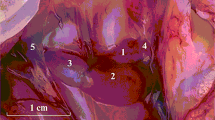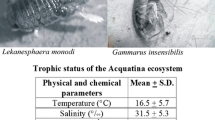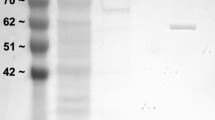Abstract
A particularly strong reduction of metabolic activity is a precondition for long-term survival ofHalicryptus spinulosus von Siebold under anoxic habitat conditions because of its relatively low fuel reserves (mainly glycogen). The present study analyses the mechanism of this metabolic slow-down. For this purpose the effects of environmental anoxia and exposure to hydrogen sulfide on the activity and selected kinetic properties of glycolytic enzymes [glycogen phosphorylase (GP), pyruvate kinase (PK)] and the concentrations of fructose-2,6-bisphosphate in the body wall ofH. spinulosus were analysed. Anoxia and hydrogen sulfide exposure stimulated modifications of the properties of the enzymes, in both cases due to probable covalent modification of the enzyme proteins. Under both conditions phosphorylase activity was depressed by about 1/3, the result of changes in the percentage of enzyme in the activea-form as well as the total amount of enzyme activity expressed (a +b). Effects of anoxia on the properties of pyruvate kinase included reducedV max , decreasedS 0.5 for phospho-enolpyruvate, changes inK a for fructose-1,6-bisphosphate (an initial decrease was followed by a later increase). TheI 50 forL-alanine of PK was extremely reduced under anoxia and showed an even greater sensitivity to the presence of hydrogen sulfide. Anoxia stimulated a slight reduction in the content of fructose-2,6-bisphosphate, whereas exposure to hydrogen sulfide caused a dramatic decrease of this allosteric activator of phos-phofructokinase. The study gives evidence that mechanisms of glycolytic rate depression are conserved within a wide variety of vertebrate and invertebrate phyla. With two exceptions (fructose-2,6-bisphosphate levels and alanine inhibition of PK) the responses to hydrogen sulfide were the same as those to anoxia, suggesting that at a metabolic level, the consequences of each stress on energy metabolism are similar.
Similar content being viewed by others
Literature cited
Famme, P., Knudsen, J., Hansen E. S. (1981). The effect of oxygen on the aerobic-anaerobic metabolism of the marine bivalve,Mytilus edulis. Mar. Biol. Lett. 2: 345–351
Hers, H.-G., Van Schaftingen, E. (1982). Fructose-2,6-bisphosphate 2 years after its discovery. Biochem. J. 206: 1–12
Holwerda, D. A., Veenhof, P.R., Van Heugten, H. A. A., Zandee, D. I. (1983). Modification of mussel pyruvate kinase during anaerobiosis and after temperature acclimation. Mol. Physiol. 3: 225–234
Job, D., Cochet, C., Dhein, A., Chambaz, E. (1978). A rapid method for screening inhibitor effects: determination of I50 and its standard deviation. Analyt. Biochem. 84: 68–77
Michaelidis, B., Gaitanaki, C., Beis, I. (1988). Modification of pyruvate kinase from the foot muscle ofPatella caerulea (L.) during anaerobiosis. J. exp. Zool. 248: 264–271
Michaelidis, B., Storey, K. B. (1990). Anaerobiosis and the regulation of glycolytic enzymes in the sea anemone,Metridium senile, J. exp. Zool.: (in press)
National Research Council (1979). Hydrogen sulfide. University Park Press, Baltimore
Oeschger, R. (1990). Long-term anaerobiosis in sublittoral marine invertebrates from the Western Baltic Sea:Halicryptus spinulosus (Priapulida),Astarte borealis andArctica islandica (Bivalvia). Mar. Ecol. Prog. Ser. 59: 133–143
Oeschger, R., Schmaljohann, R., (1988). Association of various types of epibacteria withHalicryptus spinulosus (Priapulida). Mar. Ecol. Prog. Ser. 48: 285–293
Oeschger, R., Theede, H. (1986). Untersuchungen zur Langzeit-Anaerobiose beiHalicryptus spinulosus (Priapulida). Verh. Dtsch. Zool. Ges. 79: 401
Oeschger, R., Theede, H. (1988). Use of biochemical features of macrobenthic species as indicators of long-term oxygen deficiency. Kieler Meeresforsch., Sonderh. 6: 99–110
Plaxton, W. C., Storey, K. B. (1984). Purification and properties of aerobic and anoxic forms of pyruvate kinase from the hepatopancreas of the channelled whelk,Busycotypus canaliculatum. Arch. Biochem. Biophys. 243: 195–205
Plaxton, W. C., Storey, K. B. (1985). Tissue specific isozymes of pyruvate kinase in the channelled whelkBusycotypus canaliculatum: enzyme modification in response to environmental anoxia. J. comp. Physiol. B 155: 291–296
Plaxton, W. C., Storey, K. B. (1986). Glycolytic enzyme binding and metabolic control in anaerobiosis. J. comp. Physiol. 156: 635–640
Powell, M. A., Arp, A. J. (1989). Hydrogen sulfide oxidation by abundant non-hemoglobin heme compounds in marine invertebrates from sulfide-rich habitats. J. exp. Zool. 249: 121–132
Powell, M. A., Somero, G. N. (1986). Hydrogen sulfide is coupled to oxidative phosphorylation in mitochondria ofSolemya reidi. Science, N.Y. 233: 563–566
Shick, J. M., Zwaan, A. de, Bont, A. M. T. de (1983). Anoxic metabolic rate in the musselMytilus edulis L. estimated by simultaneous direct calorimetry and biochemical analysis. Physiol. Zool. 56: 56–63
Shumway, S. E., Scott, T. M., Shick, J. M. (1983). The effects of anoxia and hydrogen sulphide on survival, activity and metabolic rate in the coot clam,Mulina lateralis (Say). J. exp. mar. Biol. Ecol 71: 135–146
Siebenaller, J. F. (1979). Regulation of pyruvate kinase inMytilus edulis by phosphorylation-dephosphorylation. Mar. Biol. Lett 1: 105–110
Stickle, W. B., Kapper, M. A., Liu, L.-L., Gnaiger, E., Wang, S. Y. (1989). Metabolic adaptations of several species of crustaceans and molluscs to hypoxia: tolerance and microcalorimetric studies. Biol. Bull. 177: 303–312
Storey, K. B. (1984). Phosphofructokinase from foot muscle of the whelk,Busycotypus canaliculatum: evidence for covalent modification of the enzyme during anaerobiosis. Arch. Biochem. Biophys. 235: 665–672
Storey, K. B. (1985a). Fructose-2,6-bisphosphate and anaerobic metabolism in marine molluscs. Fedn eur. biochem. Soc. (FEBS) Lett. 181: 245–248
Storey, K.B. (1985b), A re-evaluation of the Pasteur effect: New mechanisms in anaerobic metabolism. Mol. Physiol. 8: 439–461
Storey, K. B. (1988a). Suspended animation: the molecular basis of metabolic depression. Can. J. Zool. 66: 124–132
Storey, K. B. (1988b). Mechanisms of glycolytic control during facultative anaerobiosis in a marine mollusc: tissue-specific analysis of glycogen phosphorylase and fructose-2,6-bisphosphate. Can. J. Zool. 66: 1767–1771
Storey, K. B., Storey, J. M. (1990). Facultative metabolic rate depression: molecular regulation and biochemical adaptation in anaerobiosis, hibernation and estivation. Q. Rev. Biol.: (in press)
Theede, H. (1984). Physiological approaches to environmental problems of the Baltic. Limnologica, Berlin 15: 443–458
Theede, H., Ponat, A., Hiroki, K., Schlieper, C. (1969). Studies on the resistance of marine bottom invertebrates to oxygen deficiency and hydrogen sulphide. Mar. Biol. 2: 325–337
Van Schaftingen, E. (1984). D-Fructose-2,6-bisphosphate. In: Bergmeyer, J., Graßl, M. (eds.) Methods of enzymatic analysis. Verlag Chemie, Weinheim, p. 335–341
Zwaan, A. de, Wijsman, T. C. (1976). Anaerobic metabolism in bivalvia (Mollusca). Characteristics of anaerobic metabolism. Comp. Biochem. Physiol. 54B: 313–324
Author information
Authors and Affiliations
Additional information
Communicated by O. Kinne, Oldendorf/Luhe
Rights and permissions
About this article
Cite this article
Oeschger, R., Storey, K.B. Regulation of glycolytic enzymes in the marine invertebrateHalicryptus spinulosus (Priapulida) during environmental anoxia and exposure to hydrogen sulfide. Mar. Biol. 106, 261–266 (1990). https://doi.org/10.1007/BF01314809
Accepted:
Issue Date:
DOI: https://doi.org/10.1007/BF01314809




